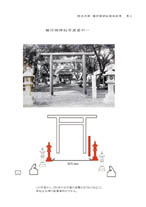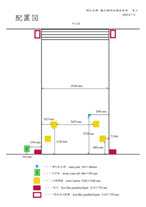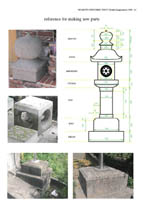In 2005, I enrolled the artist-in-residence program at Kio-A-Thau Sugar Refinery Artist Village in Ciaotou Township, Kaohsiung County in Taiwan, and preformed my project, which was for reconstructing the precinct of the shrine.
At my project, 乬Reproduce Project in the Shrine Precinct乭 was for four stone lanterns, a chizuya, guardian lion-dongs and the monument of shrine.
Most Japanese Shinto shrines in Taiwan were destroyed by Chiang Kai-shek's Kuomintang after W.W.嘦 and scattered relics of shrines still remain all around the country. Especially, Ciaotou was the starting point of Taiwan sugar industry, the axis of Japanese colonial policy, therefore various Japanese remains still exist.
Concerning the shrine, a part of stones are under the management as relics and the most part of them are untouched or remade as tables and chairs, yet other fragment of stones are still buried under the ground.
Through this project, Chen Sen-Xi, a director of Kio-A-Thau Culture Society, which is contiguous to the artist village, and living witness of Japanese-Taiwanese relations gave me his supreme support for interviews to duo-sang-aged people and researches about relics of Japanese rule.
Everyday I talked with him in the morning, then dug up to compile documentary literature in the afternoon during my stay in the residence.
It is no exaggeration to say that this is a collaboration with Chen Sen-Xirather. Our work was featured on Taiwanese TV and newspapers during the residence program. There were both arguments for and against the concept. Regrettably, a particular generations, came from China to Taiwan after World War 嘦 were violently opposed to us and I was briefly had to stop going out anywhere because of a murder announcement,
as the end result of our process, we managed to reproduce a part of shrine by some activities, such as a signature-collecting campaign and my information session.
In Kaohsiung County, nobody approved our plan, at the department of public sculpture, history and relics, and sightseeing, everything came to grief once, then the head of Kaohsiung finally took decisive measures for our project and recognized only for 乬art乭, and made a budget as an exception for us.
I insist that this is not affirmative action for the imperialization policy. The relics of the World War 嘦 must symbolize Japan-Taiwan relations rather than keep watching fading memories, even the negative side of Taiwanese history. I hope that Ciaotou shrine乫s relics from Japanese rule days exist as public arts and historic sites will give viewers various point of views by the vivid description of the history about the area. Today, a large-sized signboard about this project stands there and permanently conveys Chaotou乫s history to us.
I really appreciate all supporters of the project.
Chang Hwei-Lan: the director of this residence program.
Chin yuan: former staff of Sugar Field Factory which run Kio-A-Thau Residence program.
Zhang Zhi-Hong (artsist), Hsia Ai-Hua(artsist), Mizutani Atsushi (artist), Chen Yi-Chang(artist)
Chang Chi-Pang: member of Kio-A-Thau Culture Society.
All staff of Sugar Field Factory, who run Kio-A-Thau Residence program, and especially Chen Sen-Xi: former the director of Kio-A-Thau Culture Society.
I couldn't have wished for a better collaborator for this project.
Please accept my heartfelt thanks for your kindness.
Chang Hwei-Lan: the director of this residence
program.
Chin yuan: former staff of Sugar Field Factory which
run Kio-A-Thau Residence program.
Zhang Zhi-Hong (artsist), Hsia Ai-Hua(artsist),
Mizutani Atsushi (artist), Chen Yi-Chang(artist)
Chang Chi-Pang: member of Kio-A-Thau Culture Society.
All staff of Sugar Field Factory, who run Kio-A-Thau Residence program,
and especially Chen Sen-Xi: former the director of
Kio-A-Thau Culture Society.
I would not do anything for this project without him.
Please accept
my heartfelt thanks for your kindness.
|



















